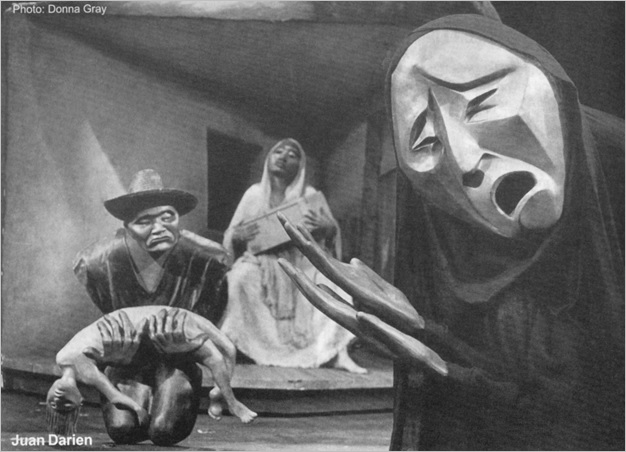

Was this the first project by you and Julie Taymor that was released on CD?
Yes. We’d performed this in smaller venues and also toured the world with it, but it was going to Lincoln Center at the time. It was highly successful and in its first year won two Obie awards in terms of off-Broadway at smaller venues. Then it toured the world a few times, but when it finally came back to a thousand-seat house like Lincoln Center, Sony Classical became interested. There was a captive audience, a thousand people who were coming in who could buy the album every night for as long as it ran.
Your mix between instruments, voices, and your style surfaces here again.
I combined music that I heard throughout Central America and parts of South America and made it very personal. This is music I associated with a carnival that I combined with a Requiem Mass and the text from Horacio Quiroga. Quiroga wrote this text that’s halfway between a passion play and a South American folk tale. I wanted to write a piece which was not in English, which was entirely in Spanish and Latin, which was done with puppets and masks, a story about transformation. Quite often in places like Latin America you’ll have a festival where you have a lot of grotesque side shows; it’s often like the Festival of St. Guadeloupe. It will be a religious festival, but at the same time there will be lurid sorts of side shows and a lot of drinking and fighting. I wanted to get the dichotomy of the collision between the carnival and the Requiem Mass.
The orchestration is very interesting because I use pre-Columbian clay flutes that the Maya and the Olmec used, which are basically ocarina-type flutes, but in various sizes and shapes which create different sounds. Combine that with synthesizer, violin, tuba, trumpet, and percussion, in a way that’s all about the world of collision, of culture, and the collision of sound. The singing was all done with very rough mezzo soprano voices, almost in a pleasant style, an angelic-sounding boy soprano and a rough-sounding male which might sound like a barker at a circus.
Did you realize you were on to something musical here that was going to filter over into your film scoring world?
Yes, there is an influence of Juan Darien in some of my film scores, but it was also even more direct than you think. In “Drugstore Cowboy” director Gus Van Sant decided to work with me because of the music he’d heard in Juan Darien;. It’s also filtered its way into “Butcher Boy” and “Titus” as well. I didn’t realize that this style would filter its way into my film scores, but I was surprised that it kept coming up.
Is the carnival part of this a subconscious expression from your childhood?

Other than just the impression of being half-Catholic, going to these festivals, and also hearing carnival music, so seeing images of saints and hearing ruckus carnival music at the same time might have played some part in that. That might have been my first impression – probably an Italian festival in Brooklyn somewhere when I was about four or five.
Did this story parallel any of the events in the life of Christ?
Yes, totally. It’s a passion play. It’s both the life of Christ, but also in a way the death of the rain forest. It’s Quiroga, the author, painting a story in which the jaguar becomes the enemy. If the jaguar, which was indeed the totem and the animal of reverence for the indigenous people in South America, becomes the enemy, then the rain forest becomes the enemy. Again, this deals with the word ‘collision’. It’s the jungle invading the church and the church invading the jungle, another important theme here.
Why did you experiment with religious concepts here?
It’s how the sacred and the profane interact. This is not only religious, but it’s basically non-religious. It’s the counterpoint between these two ideas that I find exciting.
Do you think that you and Julie have opened a door to combine faith and purity with the bizarre and dark world of some other person or character?
Yes, I definitely think we think along those same lines. I think we’re attracted to the same notion of the sacred and profane in life. I think we see those collisions and dichotomies in every day, in every place.
Were your creative intentions accomplished?
Absolutely and totally! There will probably be another production of this here and there; it’s inevitable. It’s had a lot of lifetimes; from 1987 to 1997 it has existed in one place or another.